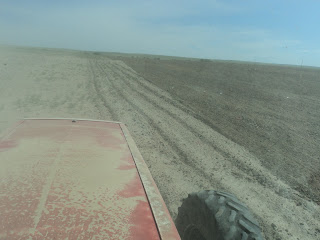First of all, windmills are fairly common in our area because they run on a natural resource we have plenty of in western Kansas...wind. They don't have to be hooked to electricity and they keep the tanks supplied with water for the cattle.
This is the windmill we were fixing today. When one stops pumping water, you have to take things apart to figure out why it isn't working. And it's a messy process.
More often than not, the problem is down underground. There are several metal rods connected to the head of the windmill (the part that looks like a fan) and they extend down into the ground. This particular windmill had about two sections of that rod underground and each section is about 20 feet long. So, to get to the problem, we had to pull out about 40 feet of pipe and "sucker" rod up from underground. We call it a sucker rod because it goes up and down and creates suction to bring the water to the surface.
Since the pipes are so long, it creates a problem. When we pull them out of the ground, we have to figure out what to do with such a long pipe. My job is to climb up the windmill and stand up there to guide the pipe so it doesn't get caught on anything. Since I'm scared of heights, this isn't exactly a job that I love.
Here's the view from where I stand. To put it in perspective, the top of my head was usually about as high as the wooden platform you can seen on the windmill in the top picture.
You might notice the pipe that goes across just below my feet that has something hooked on it. This is the pipe we slide through the legs of the windmill to hook our pulley and rope system to. Twenty feet of pipe (sometimes filled with water) is pretty heavy. If it were to slip out of our hands it would be lost in the well. So, we use a pulley and "pipe jack" to prevent that from happening.
Pipe Jack-holds the pipe in place so we don't have to hold it by hand.
In the above picture, dad has vice grips clamped on the sucker rod so that it won't fall down into the well while the pipe jack holds the pipe in place. We have had the sucker rod fall down in the well before and it isn't exactly easy to fish it out.
This is the cylinder at the very bottom of the pipe. It is the very last thing in the bottom of the well. It contains all of the technical stuff like a foot valve and leathers...which I don't know a ton about ;-) But somehow all of that combines to create the suction needed to pull the water up the pipe and also keep it from draining right back down the hole.
Today, as usual, our problem was in the very bottom. One of the rods connecting to the stuff in the cylinder had come unscrewed because the threads were becoming stripped (meaning they were getting worn down so they wouldn't stay screwed together). So, we loaded the problem piece up, took it to the house where dad created a new piece with better threads (so that it wouldn't come unscrewed)
Then it was back to the windmill to put it all back together again.
Fixing a windmill is usually a bit more gratifying on a hot day...but it also makes it more miserable. However, the reward of nice cold water gushing out the pipe is always the best part. Dad and I always have to wash up our hands in the fresh water and usually end up getting a little bit on each other as well ;-) Today it was a little chilly, so we didn't have any water fights.
Now, the next thing is to hope that our tank (which had several holes we also tried patching) actually holds the water the windmill is now pumping into it. Have a great week and I'm on to the next adventure!

.jpg)
.jpg)

.jpg)

.jpg)
.jpg)













